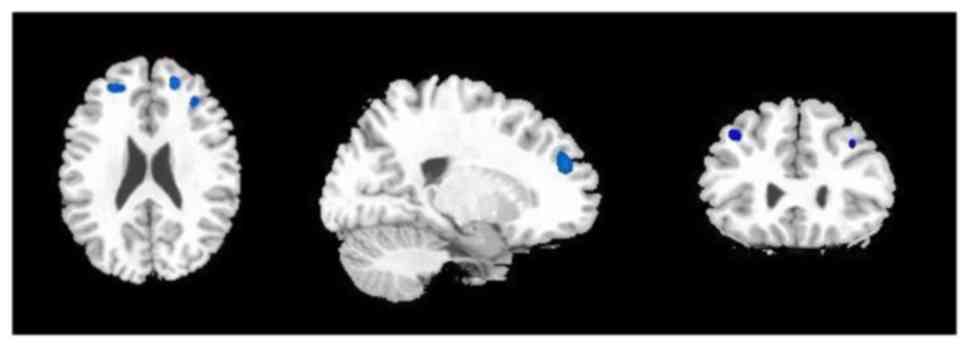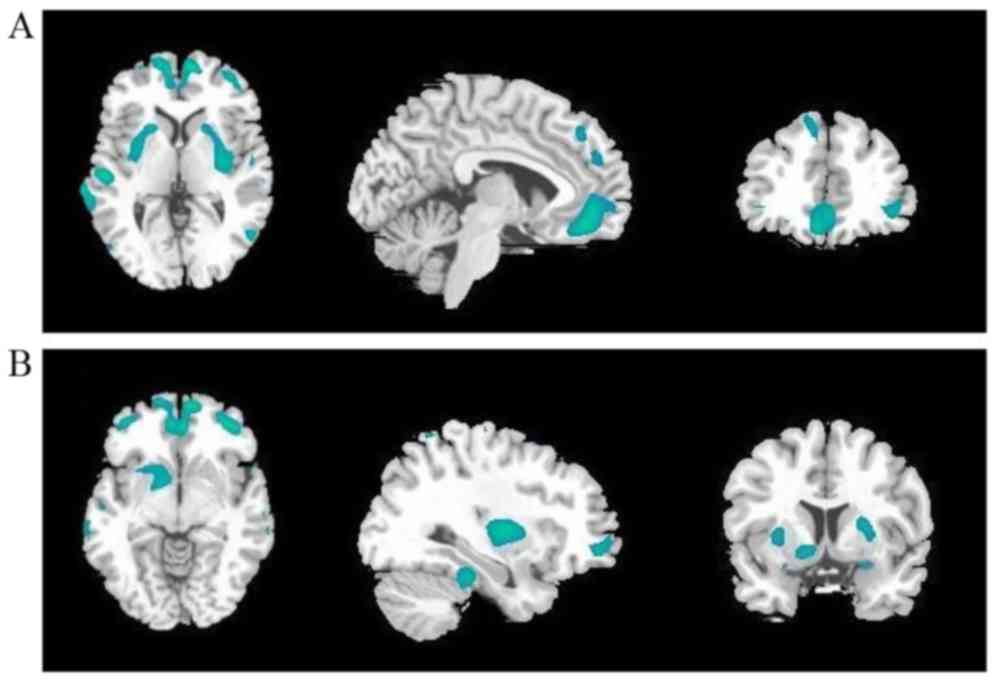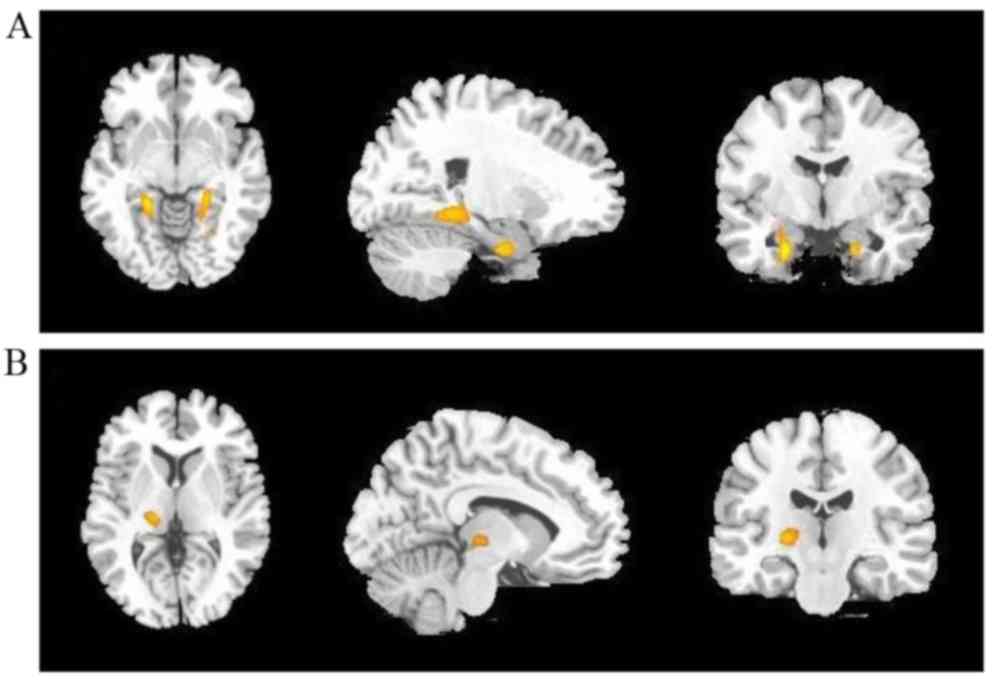|
1
|
Knutson B, Bhanji JP, Cooney RE, Atlas LY
and Gotlib IH: Neural responses to monetary incentives in major
depression. Biol Psychiatry. 63:686–692. 2008. View Article : Google Scholar : PubMed/NCBI
|
|
2
|
Adrien J: Neurobiological bases for the
relation between sleep and depression. Sleep Med Rev. 6:341–351.
2002. View Article : Google Scholar : PubMed/NCBI
|
|
3
|
Macey PM, Woo MA, Kumar R, Cross RL and
Harper RM: Relationship between obstructive sleep apnea severity
and sleep, depression and anxiety symptoms in newly-diagnosed
patients. PLoS One. 5:e102112010. View Article : Google Scholar : PubMed/NCBI
|
|
4
|
Kameyama M, Fukuda M, Yamagishi Y, Sato T,
Uehara T, Ito M, Suto T and Mikuni M: Frontal lobe function in
bipolar disorder: A multichannel near-infrared spectroscopy study.
Neuroimage. 29:172–184. 2006. View Article : Google Scholar : PubMed/NCBI
|
|
5
|
Galazzo I Boscolo, Mattoli MV, Pizzini FB,
De Vita E, Barnes A, Duncan JS, Jäger HR, Golay X, Bomanji JB,
Koepp M, et al: Cerebral metabolism and perfusion in MR-negative
individuals with refractory focal epilepsy assessed by simultaneous
acquisition of (18)F-FDG PET and arterial spin labeling. Neuroimage
Clin. 11:648–657. 2016. View Article : Google Scholar : PubMed/NCBI
|
|
6
|
Lee HS, Choo IH, Lee DY, Kim JW, Seo EH,
Kim SG, Park SY, Shin JH, Kim KW and Woo JI: Frontal dysfunction
underlies depression in mild cognitive impairment: A FDG-PET study.
Psychiatry Investig. 7:208–214. 2010. View Article : Google Scholar : PubMed/NCBI
|
|
7
|
Lui S, Parkes LM, Huang X, Zou K, Chan RC,
Yang H, Zou L, Li D, Tang H, Zhang T, et al: Depressive disorders:
Focally altered cerebral perfusion measured with arterial
spin-labeling MR imaging. Radiology. 251:476–484. 2009. View Article : Google Scholar : PubMed/NCBI
|
|
8
|
Mayberg HS, Brannan SK, Tekell JL, Silva
JA, Mahurin RK, McGinnis S and Jerabek PA: Regional metabolic
effects of fluoxetine in major depression: Serial changes and
relationship to clinical response. Biol Psychiatry. 48:830–843.
2000. View Article : Google Scholar : PubMed/NCBI
|
|
9
|
Hamilton M: A rating scale for depression.
J Neurol Neurosurg Psychiatry. 23:56–62. 1960. View Article : Google Scholar : PubMed/NCBI
|
|
10
|
Vasic N, Wolf ND, Grön G, Sosic-Vasic Z,
Connemann BJ, Sambataro F, von Strombeck A, Lang D, Otte S, Dudek M
and Wolf RC: Baseline brain perfusion and brain structure in
patients with major depression: A multimodal magnetic resonance
imaging study. J Psychiatry Neurosci. 40:412–421. 2015. View Article : Google Scholar : PubMed/NCBI
|
|
11
|
Graff-Guerrero A, González-Olvera J,
Mendoza-Espinosa Y, Vaugier V and Garcı́a-Reyna JC: Correlation
between cerebral blood flow and items of the Hamilton rating scale
for depression in antidepressant-naive patients. J Affect Disord.
80:55–63. 2004. View Article : Google Scholar : PubMed/NCBI
|
|
12
|
Wu JC, Gillin JC, Buchsbaum MS, Schachat
C, Darnall LA, Keator DB, Fallon JH and Bunney WE: Sleep
deprivation PET correlations of Hamilton symptom improvement
ratings with changes in relative glucose metabolism in patients
with depression. J Affect Disord. 107:181–186. 2008. View Article : Google Scholar : PubMed/NCBI
|
|
13
|
American Psychiatric Association, .
Diagnostic and statistical manual of mental disorders. 4th.
Washington, DC: 2000
|
|
14
|
Maier W, Buller R, Philipp M and Heuser I:
The Hamilton anxiety scale: Reliability, validity and sensitivity
to change in anxiety and depressive disorders. J Affect Disord.
14:61–68. 1988. View Article : Google Scholar : PubMed/NCBI
|
|
15
|
Orosz A, Jann K, Federspiel A, Horn H,
Höfle O, Dierks T, Wiest R, Strik W, Müller T and Walther S:
Reduced cerebral blood flow within the default-mode network and
within total gray matter in major depression. Brain Connect.
2:303–310. 2012. View Article : Google Scholar : PubMed/NCBI
|
|
16
|
Wei K, Xue HL, Guan YH, Zuo CT, Ge JJ,
Zhang HY, Liu BJ, Cao YX, Dong JC and Du YJ: Analysis of glucose
metabolism of (18)F-FDG in major depression patients using PET
imaging: Correlation of salivary cortisol and α-amylase. Neurosci
Lett. 629:52–57. 2016. View Article : Google Scholar : PubMed/NCBI
|
|
17
|
Clark L, Chamberlain SR and Sahakian BJ:
Neurocognitive mechanisms in depression: Implications for
treatment. Annu Rev Neurosci. 32:57–74. 2009. View Article : Google Scholar : PubMed/NCBI
|
|
18
|
Seminowicz D, Mayberg H, McIntosh A,
Goldapple K, Kennedy S, Segal Z and Rafi-Tari S: Limbic-frontal
circuitry in major depression: A path modeling metanalysis.
Neuroimage. 22:409–418. 2004. View Article : Google Scholar : PubMed/NCBI
|
|
19
|
Nauta WJ: Neural associations of the
frontal cortex. Acta Neurobiol Exp (Wars). 32:125–140.
1972.PubMed/NCBI
|
|
20
|
van Hoeij F, Keijsers R, Loffeld B, Dun G,
Stadhouders P and Weusten B: Incidental colonic focal FDG uptake on
PET/CT: Can the maximum standardized uptake value (SUVmax) guide us
in the timing of colonoscopy? Eur J Nucl Med Mol Imaging. 42:66–71.
2015. View Article : Google Scholar : PubMed/NCBI
|
|
21
|
Vidorreta M, Wang Z, Rodríguez I, Pastor
MA, Detre JA and Fernández-Seara MA: Comparison of 2D and 3D
single-shot ASL perfusion fMRI sequences. Neuroimage. 66:662–671.
2013. View Article : Google Scholar : PubMed/NCBI
|
|
22
|
Towgood KJ, Pitkanen M, Kulasegaram R,
Fradera A, Soni S, Sibtain N, Reed LJ, Bradbeer C, Barker GJ, Dunn
JT, et al: Regional cerebral blood flow and FDG uptake in
asymptomatic HIV-1 men. Hum Brain Mapp. 34:2484–2493. 2013.
View Article : Google Scholar : PubMed/NCBI
|
|
23
|
Greicius MD, Flores BH, Menon V, Glover
GH, Solvason HB, Kenna H, Reiss AL and Schatzberg AF: Resting-state
functional connectivity in major depression: Abnormally increased
contributions from subgenual cingulate cortex and thalamus. Biol
Psychiatry. 62:429–437. 2007. View Article : Google Scholar : PubMed/NCBI
|
|
24
|
Lui S, Deng W, Huang X, Jiang L, Ma X,
Chen H, Zhang T, Li X, Li D, Zou L, et al: Association of cerebral
deficits with clinical symptoms in antipsychotic-naive
first-episode schizophrenia: An optimized voxel-based morphometry
and resting state functional connectivity study. Am J Psychiatry.
166:196–205. 2009. View Article : Google Scholar : PubMed/NCBI
|
|
25
|
Hamilton JP, Etkin A, Furman DJ, Lemus MG,
Johnson RF and Gotlib IH: Functional neuroimaging of major
depressive disorder: A meta-analysis and new integration of base
line activation and neural response data. Am J Psychiatry.
169:693–703. 2012. View Article : Google Scholar : PubMed/NCBI
|
|
26
|
Nishi H, Sawamoto N, Namiki C, Yoshida H,
Dinh HD, Ishizu K, Hashikawa K and Fukuyama H: Correlation between
cognitive deficits and glucose hypometabolism in mild cognitive
impairment. J Neuroimaging. 20:29–36. 2010. View Article : Google Scholar : PubMed/NCBI
|
|
27
|
Bench CJ, Friston KJ, Brown RG, Scott LC,
Frackowiak RS and Dolan RJ: The anatomy of melancholia-focal
abnormalities of cerebral blood flow in major depression. Psychol
Med. 22:607–615. 1992. View Article : Google Scholar : PubMed/NCBI
|
|
28
|
Brody AL, Saxena S, Silverman DH,
Alborzian S, Fairbanks LA, Phelps ME, Huang SC, Wu HM, Maidment K
and Baxter LR Jr: Brain metabolic changes in major depressive
disorder from pre-to post-treatment with paroxetine. Psychiatry
Res. 91:127–139. 1999. View Article : Google Scholar : PubMed/NCBI
|
|
29
|
Kennedy SH, Evans KR, Krüger S, Mayberg
HS, Meyer JH, McCann S, Arifuzzman AI, Houle S and Vaccarino FJ:
Changes in regional brain glucose metabolism measured with positron
emission tomography after paroxetine treatment of major depression.
Am J Psychiatry. 158:899–905. 2001. View Article : Google Scholar : PubMed/NCBI
|
|
30
|
Kimbrell TA, Ketter TA, George MS, Little
JT, Benson BE, Willis MW, Herscovitch P and Post RM: Regional
cerebral glucose utilization in patients with a range of severities
of unipolar depression. Biol Psychiatry. 51:237–252. 2002.
View Article : Google Scholar : PubMed/NCBI
|
|
31
|
de Asis JM, Silbersweig DA, Pan H, Young
RC and Stern E: Neuroimaging studies of fronto-limbic dysfunction
in geriatric depression. Clin Neurosci Res. 2:324–330. 2003.
View Article : Google Scholar
|

















